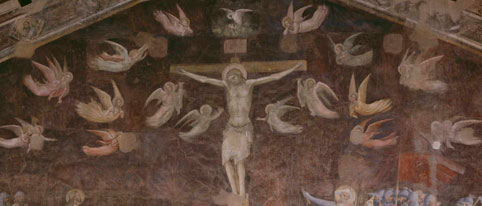BASILICA DI SANTO SPIRITO - affresco attribuito ad Andrea di Cione detto l'Orcagna
intervento di manutenzione previa analisi dello stato di conservazione con campagna diagnostica - MAINTENANCE AFTER ANALYSIS OF THE STATE OF PRESERVATION BY A DIAGNOSTIC CAMPAIGN

La Chiesa di Santo Spirito, considerata l'ultimo capolavoro del Brunelleschi, è caratterizzata da una facciata estremamente semplice ed elegante. L'ambiente del refettorio, dove è conservato l'affresco, era uno dei rari resti del convento medievale dopo la ristrutturazione quattrocentesca di Filippo Brunelleschi, ma, scialbato, venne destinato dopo la soppressione del convento a usi impropri, tra cui quello di deposito dei tram, a fine dell'Ottocento. Tale uso richiese l'apertura di un largo portone sul lato est, quello dove poi vennero riscoperti gli affreschi: andarono così irrimediabilmente perduti i piedi della crocifissione e gran parte dell' Ultima Cena.
The Church of Santo Spirito, considered Brunelleschi’s last masterpiece, is characterized by an extremely simple and elegant facade. The refectory's space, where the fresco is preserved, was one of the rare remains of the medieval convent after the fifteenth-century renovation by Filippo Brunelleschi, but, being painted, it was destined to improper uses after the suppression of the convent, including that of tram depot, at the end of the nineteenth century. This use had required the opening of a large door on the east side, the one where the frescoes were then rediscovered. Owing to this, the feet of the crucifixion and much of the Last Supper were thus irremediably lost.
Valore del’intervento:€ 90.000.00 / Value of the intervention: € 90.000.00
Durata dei lavori:180 gg / Duration of works: 180 days
Tipologia Intervento: l'intervento è finalizzato ad una importante manutenzione tesa ad intervenire sulle criticità più urgenti.
Intervention typology: the intervention is aimed at an important maintenance aimed at intervening on the most urgent critical issues.
Attrattività: alta
Attractiveness: high
Notizie storico-artistiche: l'opera ha ricevuto una attenzione conservativa con approccio diverso da parte dell’ultimo restauro degli anni ’70. Infatti in quel caso è stato condotto dal restauratore Leonetto Tintori che ha praticato le migliori conoscenze dell’epoca in fatto di materiali sintetici utili al contenimento degli effetti deturpanti del processo di degrado della solfatazione, di cui erano sicuramente affetti anche questi affreschi. Per contro, nel restauro del 1974 eseguito dal restauratore Dino Dini sulla Crocifissione dell’Angelico, veniva messo a punto per la prima volta il metodo di trasformazione chimico fisica della solfatazione con applicazione di carbonato di ammonio e idrossido di bario, denominato anche “metodo Ferroni-Dini”.
Historical-artistic information: the work has received a conservative attention with a different approach as compared to the last restoration of the 70s. In fact in that case it was conducted by the restorer Leonetto Tintori who applied the best knowledge of the time in terms of synthetic materials. This was useful to contain the disfiguring effects of the sulfation degradation process which
